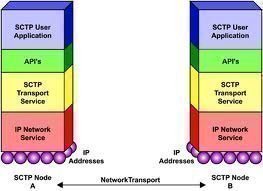SCTP (Stream Control Transmission Protocol)
The Stream Control Transmission Protocol (SCTP) is a reliable transport protocol that works on a connectionless IP packet network. It transports Public Switched Telephone Network (PSTN) messages over networks and also has other functions. SCTP was created in order to correct the TCP’s shortcomings, while carrying real-time signaling information over a network. It also runs on top of the UDP network layer if and when required.
Services that SCTP Offers
The SCTP offers the following services:
- Fragments data to the discovered path MTU size.
- Transfers Error free, non-duplicated user data that is acknowledged.
- Bundles multiple user messages into a single SCTP packet.
- Conducts sequenced delivery of user messages within multiple streams, which includes an option for users to determine the arrival delivery’s message order.

- Fault tolerance at the network level through multi-homing support.
SCTP’S Advantages
The SCTP design incorporates congestion avoidance and automatic resistance to network masquerade attacks and flooding. The packet datagrams are made up of a common packet header and chunks of information that are comprised of user data and control information. As a result, the SCTP is used as a core protocol in the SIGTRAN protocol stack that also includes transport layer services for SS7/C7 over IP. Some of these uses include signal movement between a media gateway controller and signaling gateway, and transporting TCAP between a signaling gateway and other network nodes.
What are the Non-signaling Applications of SCTP?
The SCTP has the following non-signaling applications:
- Transports IP flow information export traffic within the network.
- Transports Reliable Server pooling data traffic.
- Transports Remote Direct Data Placement and Block Storage traffic.
- Transports authentication, accounting, and authorization information.
What is the Stream Control Transmission Protocol’s Structure?
The structure protocol definition defines the Stream Control Transmission Protocol and the source port number that has the SCTP sender’s port number that the receiver uses with the source IP address to identify the datagram association, destination port number, verification tag, and datagram checksum. The SCTP datagram uses an Adler-32 checksum for error verification.


Comments - No Responses to “SCTP (Stream Control Transmission Protocol)”
Sorry but comments are closed at this time.